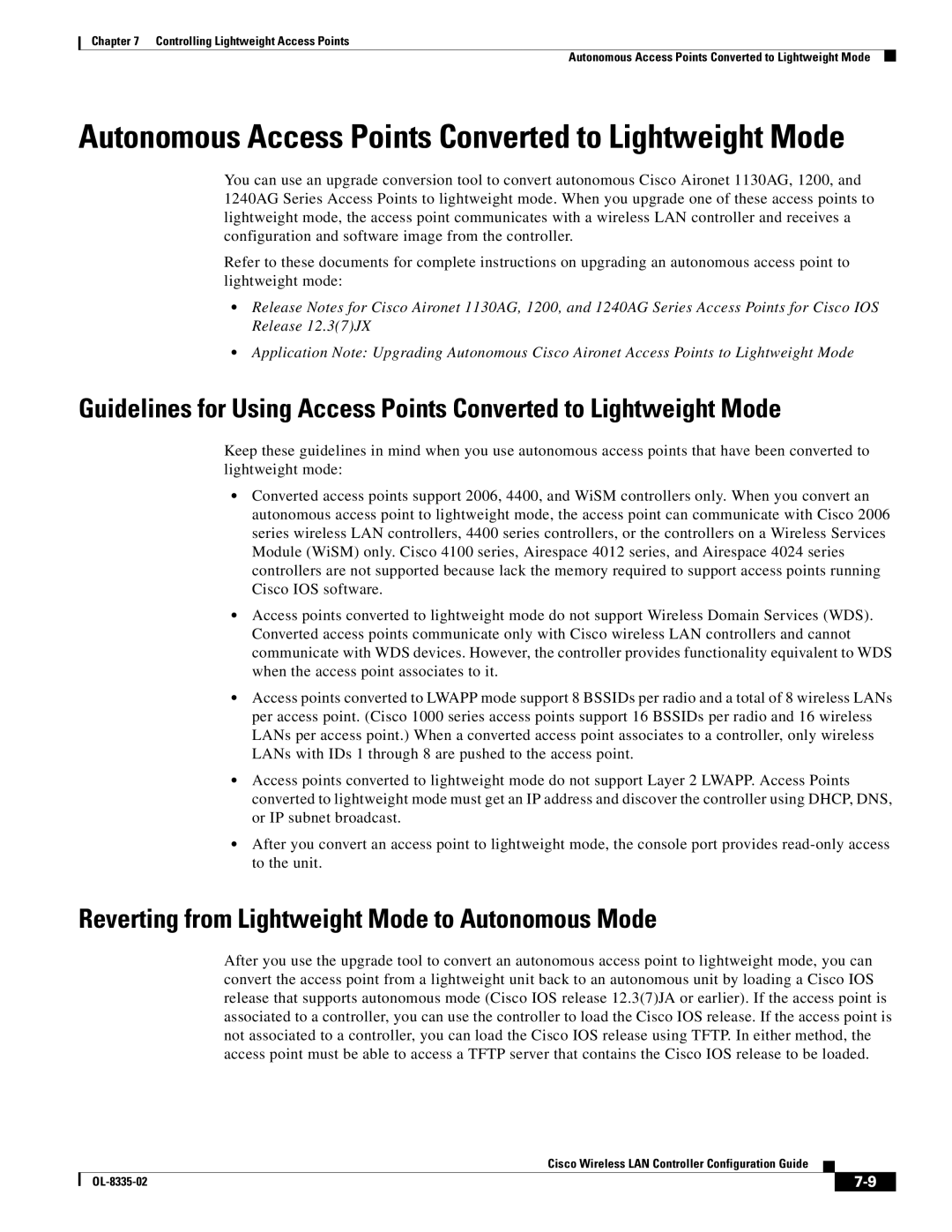
Chapter 7 Controlling Lightweight Access Points
Autonomous Access Points Converted to Lightweight Mode
Autonomous Access Points Converted to Lightweight Mode
You can use an upgrade conversion tool to convert autonomous Cisco Aironet 1130AG, 1200, and 1240AG Series Access Points to lightweight mode. When you upgrade one of these access points to lightweight mode, the access point communicates with a wireless LAN controller and receives a configuration and software image from the controller.
Refer to these documents for complete instructions on upgrading an autonomous access point to lightweight mode:
•Release Notes for Cisco Aironet 1130AG, 1200, and 1240AG Series Access Points for Cisco IOS Release 12.3(7)JX
•Application Note: Upgrading Autonomous Cisco Aironet Access Points to Lightweight Mode
Guidelines for Using Access Points Converted to Lightweight Mode
Keep these guidelines in mind when you use autonomous access points that have been converted to lightweight mode:
•Converted access points support 2006, 4400, and WiSM controllers only. When you convert an autonomous access point to lightweight mode, the access point can communicate with Cisco 2006 series wireless LAN controllers, 4400 series controllers, or the controllers on a Wireless Services Module (WiSM) only. Cisco 4100 series, Airespace 4012 series, and Airespace 4024 series controllers are not supported because lack the memory required to support access points running Cisco IOS software.
•Access points converted to lightweight mode do not support Wireless Domain Services (WDS). Converted access points communicate only with Cisco wireless LAN controllers and cannot communicate with WDS devices. However, the controller provides functionality equivalent to WDS when the access point associates to it.
•Access points converted to LWAPP mode support 8 BSSIDs per radio and a total of 8 wireless LANs per access point. (Cisco 1000 series access points support 16 BSSIDs per radio and 16 wireless LANs per access point.) When a converted access point associates to a controller, only wireless LANs with IDs 1 through 8 are pushed to the access point.
•Access points converted to lightweight mode do not support Layer 2 LWAPP. Access Points converted to lightweight mode must get an IP address and discover the controller using DHCP, DNS, or IP subnet broadcast.
•After you convert an access point to lightweight mode, the console port provides
Reverting from Lightweight Mode to Autonomous Mode
After you use the upgrade tool to convert an autonomous access point to lightweight mode, you can convert the access point from a lightweight unit back to an autonomous unit by loading a Cisco IOS release that supports autonomous mode (Cisco IOS release 12.3(7)JA or earlier). If the access point is associated to a controller, you can use the controller to load the Cisco IOS release. If the access point is not associated to a controller, you can load the Cisco IOS release using TFTP. In either method, the access point must be able to access a TFTP server that contains the Cisco IOS release to be loaded.
Cisco Wireless LAN Controller Configuration Guide
|
| ||
|
|
